第8章 日本語 WaveNet 音声合成システムの実装¶
Google colabでの実行における推定所要時間: 5時間
このノートブックに記載のレシピの設定は、Google Colab上で実行した場合のタイムアウトを避けるため、学習条件を書籍に記載の設定から一部修正していることに注意してください (バッチサイズを減らす等)。 参考までに、書籍に記載の条件で、著者 (山本) がレシピを実行した結果を以下で公開しています。
Tensorboard logs: https://tensorboard.dev/experiment/yXyg9qgfQRSGxvil5FA4xw/
expディレクトリ(学習済みモデル、合成音声を含む) : https://drive.google.com/file/d/1Z09yCCAKyKOUU3Zsdxs0mZ1Q-TCPqFHA/view?usp=sharing (135.2 MB)
準備¶
Google Colabを利用する場合¶
Google Colab上でこのノートブックを実行する場合は、メニューの「ランタイム -> ランタイムのタイムの変更」から、「ハードウェア アクセラレータ」を GPU に変更してください。
Python version¶
[1]:
!python -VV
Python 3.8.6 | packaged by conda-forge | (default, Dec 26 2020, 05:05:16)
[GCC 9.3.0]
ttslearn のインストール¶
[2]:
%%capture
try:
import ttslearn
except ImportError:
!pip install ttslearn
[3]:
import ttslearn
ttslearn.__version__
[3]:
'0.2.1'
8.1 本章の日本語音声合成システムの実装¶
学習済みモデルを用いた音声合成¶
[4]:
from ttslearn.wavenet import WaveNetTTS
from tqdm.notebook import tqdm
from IPython.display import Audio
engine = WaveNetTTS()
wav, sr = engine.tts("ウェーブネットにチャレンジしましょう!", tqdm=tqdm)
Audio(wav, rate=sr)
[4]:
[5]:
import librosa.display
import matplotlib.pyplot as plt
import numpy as np
fig, ax = plt.subplots(figsize=(8,2))
librosa.display.waveplot(wav.astype(np.float32), sr, ax=ax)
ax.set_xlabel("Time [sec]")
ax.set_ylabel("Amplitude")
plt.tight_layout()

レシピ実行の前準備¶
[6]:
%%capture
from ttslearn.env import is_colab
from os.path import exists
# pip install ttslearn ではレシピはインストールされないので、手動でダウンロード
if is_colab() and not exists("recipes.zip"):
!curl -LO https://github.com/r9y9/ttslearn/releases/download/v{ttslearn.__version__}/recipes.zip
!unzip -o recipes.zip
[7]:
import os
# recipeのディレクトリに移動
cwd = os.getcwd()
if cwd.endswith("notebooks"):
os.chdir("../recipes/wavenet/")
elif is_colab():
os.chdir("recipes/wavenet/")
[8]:
import time
start_time = time.time()
パッケージのインポート¶
[9]:
%pylab inline
%load_ext autoreload
%load_ext tensorboard
%autoreload
import IPython
from IPython.display import Audio
import tensorboard as tb
import os
Populating the interactive namespace from numpy and matplotlib
[10]:
# 数値演算
import numpy as np
import torch
from torch import nn
# 音声波形の読み込み
from scipy.io import wavfile
# フルコンテキストラベル、質問ファイルの読み込み
from nnmnkwii.io import hts
# 音声分析
import pyworld
# 音声分析、可視化
import librosa
import librosa.display
import pandas as pd
# Pythonで学ぶ音声合成
import ttslearn
[11]:
# シードの固定
from ttslearn.util import init_seed
init_seed(773)
[12]:
torch.__version__
[12]:
'1.8.1'
描画周りの設定¶
[13]:
from ttslearn.notebook import get_cmap, init_plot_style, savefig
cmap = get_cmap()
init_plot_style()
レシピの設定¶
[14]:
# run.shを利用した学習スクリプトをnotebookから行いたい場合は、True
# google colab の場合は、True とします
# ローカル環境の場合、run.sh をターミナルから実行することを推奨します。
# その場合、このノートブックは可視化・学習済みモデルのテストのために利用します。
run_sh = is_colab()
# 注意: WaveNetを利用した評価データに対する音声生成は時間がかかることに注意
run_stage8 = True
# run.sh経由で実行するスクリプトのtqdm
run_sh_tqdm = "none"
# CUDA
# NOTE: run.shの引数として渡すので、boolではなく文字列で定義しています
cudnn_benchmark = "true"
cudnn_deterministic = "false"
# 特徴抽出時の並列処理のジョブ数
n_jobs = os.cpu_count()//2
# 継続長モデルの設定ファイル名
duration_config_name="duration_rnn"
# 音響モデルの設定ファイル名
logf0_config_name="logf0_rnn"
# WaveNetの設定ファイル名
wavenet_config_name="wavenet_sr16k_mulaw256"
# 継続長モデル & 対数F0予測モデルの学習におけるバッチサイズ
dnntts_batch_size = 32
# 継続長モデル & 対数F0予測モデルの学習におけるエポック数
# 注意: 計算時間を少なくするために、少なく設定しています。品質を向上させるためには、30 ~ 50 のエポック数を試してみてください。
dnntts_nepochs = 5
# WaveNet学習におけるバッチサイズ
# 推奨バッチサイズ: 8以上
# 動作確認のため、小さな値に設定しています
wavenet_batch_size = 4
# WavaNetの学習イテレーション数
# 注意: 十分な品質を得るために必要な値: 300k ~ 500k steps
wavenet_max_train_steps = 50000
# 音声生成を行う発話数
# WaveNetの推論は時間がかかるので、ノートブックで表示する5つのみ生成する
num_eval_utts = 5
# ノートブックで利用するテスト用の発話(学習データ、評価データ)
train_utt = "BASIC5000_0001"
test_utt = "BASIC5000_5000"
Tensorboard によるログの可視化¶
[15]:
# ノートブック上から tensorboard のログを確認する場合、次の行を有効にしてください
if is_colab():
%tensorboard --logdir tensorboard/
プログラム実装の前準備¶
stage -1: コーパスのダウンロード¶
[16]:
if is_colab():
! ./run.sh --stage -1 --stop-stage -1
Stage 0: 学習/検証/評価データの分割¶
[17]:
if run_sh:
! ./run.sh --stage 0 --stop-stage 0
[18]:
! ls data/
dev.list eval.list train.list utt_list.txt
[19]:
! head data/dev.list
BASIC5000_4574
BASIC5000_4575
BASIC5000_4576
BASIC5000_4578
BASIC5000_4579
BASIC5000_4580
BASIC5000_4582
BASIC5000_4583
BASIC5000_4584
BASIC5000_4585
8.2 データの前処理¶
継続長モデルのための前処理¶
バッチ処理を行うコマンドラインプログラムは、 recipes/dnntts/preprocess_duration.py を参照してください。
[20]:
if run_sh:
! ./run.sh --stage 1 --stop-stage 1 --n-jobs $n_jobs
対数 F0 予測モデルのための前処理¶
対数F0 + 有声/無声フラグの計算¶
[21]:
from nnmnkwii.preprocessing import delta_features
from nnmnkwii.preprocessing.f0 import interp1d
from ttslearn.dsp import f0_to_lf0
def world_log_f0_vuv(x, sr):
f0, timeaxis = pyworld.dio(x, sr)
f0 = pyworld.stonemask(x, f0, timeaxis, sr)
vuv = (f0 > 0).astype(np.float32)
# 連続対数基本周波数
lf0 = f0_to_lf0(f0)
lf0 = interp1d(lf0)
# 連続基本周波数と有声/無声フラグを2次元の行列の形にしておく
lf0 = lf0[:, np.newaxis] if len(lf0.shape) == 1 else lf0
vuv = vuv[:, np.newaxis] if len(vuv.shape) == 1 else vuv
# 動的特徴量の計算
windows = [
[1.0], # 静的特徴量に対する窓
[-0.5, 0.0, 0.5], # 1 次動的特徴量に対する窓
[1.0, -2.0, 1.0], # 2 次動的特徴量に対する窓
]
lf0 = delta_features(lf0, windows)
# すべての特徴量を結合
feats = np.hstack([lf0, vuv]).astype(np.float32)
return feats
対数F0 + 有声/無声フラグの可視化¶
[22]:
from ttslearn.dsp import lf0_to_f0
sr = 16000
_sr, x = wavfile.read(ttslearn.util.example_audio_file())
x = (x / 32768).astype(np.float64)
x = librosa.resample(x, _sr, sr)
out_feats = world_log_f0_vuv(x, sr)
lf0 = out_feats[:, 0]
vuv = out_feats[:, -1]
timeaxis = librosa.frames_to_time(np.arange(len(lf0)), sr, int(0.005 * sr))
fig, ax = plt.subplots(3,1, figsize=(8,6))
ax[0].set_title("Input waveform")
ax[1].set_title("Continuous log F0")
ax[2].set_title("V/UV")
librosa.display.waveplot(x, sr, x_axis="time", ax=ax[0])
ax[1].plot(timeaxis, lf0, linewidth=2)
ax[2].plot(timeaxis, vuv, linewidth=2)
for a in ax:
a.set_xlabel("Time [sec]")
a.set_xlim(0, len(x)/sr)
a.set_xticks(np.arange(0, 3.5, 0.5))
a.xaxis.set_major_formatter(FormatStrFormatter('%.1f'))
ax[0].set_ylabel("Amplitude")
ax[1].set_ylabel("Logarithmic frequency")
ax[2].set_ylabel("Binary value")
plt.tight_layout()
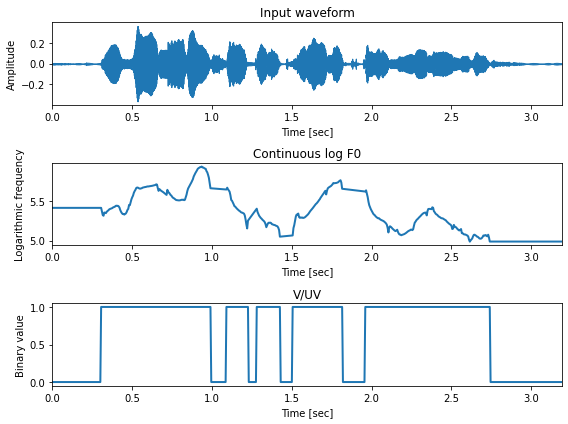
1発話に対する前処理¶
[23]:
from nnmnkwii.frontend import merlin as fe
# HTS 形式の質問ファイルを読み込み
binary_dict, numeric_dict = hts.load_question_set(ttslearn.util.example_qst_file())
# フルコンテキストラベルの読み込み
labels = hts.load(ttslearn.util.example_label_file())
# フレーム単位の言語特徴量を抽出
in_feats = fe.linguistic_features(
labels,
binary_dict,
numeric_dict,
add_frame_features=True,
subphone_features="coarse_coding",
)
# 音声ファイルの読み込み
sr = 16000
_sr, x = wavfile.read(ttslearn.util.example_audio_file())
x = (x / 32768).astype(np.float64)
x = librosa.resample(x, _sr, sr)
# 連続対数基本周波数と有声/無声フラグを結合した特徴量の計算
out_feats = world_log_f0_vuv(x.astype(np.float64), sr)
# フレーム数の調整
minL = min(in_feats.shape[0], out_feats.shape[0])
in_feats, out_feats = in_feats[:minL], out_feats[:minL]
# 冒頭と末尾の非音声区間の長さを調整
assert "sil" in labels.contexts[0] and "sil" in labels.contexts[-1]
start_frame = int(labels.start_times[1] / 50000)
end_frame = int(labels.end_times[-2] / 50000)
# 冒頭:50 ミリ秒、末尾:100 ミリ秒
start_frame = max(0, start_frame - int(0.050 / 0.005))
end_frame = min(minL, end_frame + int(0.100 / 0.005))
in_feats = in_feats[start_frame:end_frame]
out_feats = out_feats[start_frame:end_frame]
[24]:
print ("入力特徴量のサイズ:", in_feats.shape)
print ("出力特徴量のサイズ:", out_feats.shape)
入力特徴量のサイズ: (568, 329)
出力特徴量のサイズ: (568, 4)
レシピの stage 2 の実行¶
上記の処理を行うバッチ処理のプログラムは、preprocess_logf0.py にあります。
[25]:
if run_sh:
! ./run.sh --stage 2 --stop-stage 2 --n-jobs $n_jobs
WaveNet のための前処理¶
1発話に対する前処理¶
[26]:
from ttslearn.dsp import mulaw_quantize
from ttslearn.dsp import world_log_f0_vuv
# HTS 形式の質問ファイルを読み込み
binary_dict, numeric_dict = hts.load_question_set(ttslearn.util.example_qst_file())
# フルコンテキストラベルの読み込み
labels = hts.load(ttslearn.util.example_label_file())
# フレーム単位の言語特徴量の抽出
in_feats = fe.linguistic_features(
labels,
binary_dict,
numeric_dict,
add_frame_features=True,
subphone_features="coarse_coding",
)
# 音声ファイルの読み込み
sr = 16000
_sr, x = wavfile.read(ttslearn.util.example_audio_file())
x = (x / 32768).astype(np.float64)
x = librosa.resample(x, _sr, sr)
# 連続対数基本周波数と有声/無声フラグを結合した特徴量の計算
log_f0_vuv = world_log_f0_vuv(x.astype(np.float64), sr)
# フレーム数の調整
minL = min(in_feats.shape[0], log_f0_vuv.shape[0])
in_feats, log_f0_vuv = in_feats[:minL], log_f0_vuv[:minL]
# 冒頭と末尾の非音声区間の長さを調整
assert "sil" in labels.contexts[0] and "sil" in labels.contexts[-1]
start_frame = int(labels.start_times[1] / 50000)
end_frame = int(labels.end_times[-2] / 50000)
# 冒頭:50 ミリ秒、末尾:100 ミリ秒
start_frame = max(0, start_frame - int(0.050 / 0.005))
end_frame = min(minL, end_frame + int(0.100 / 0.005))
in_feats = in_feats[start_frame:end_frame]
log_f0_vuv = log_f0_vuv[start_frame:end_frame]
# 言語特徴量と連続対数基本周波数を結合
in_feats = np.hstack([in_feats, log_f0_vuv])
# 時間領域で音声の長さを調整
x = x[int(start_frame * 0.005 * sr) :]
length = int(sr * 0.005) * in_feats.shape[0]
x = pad_1d(x, length) if len(x) < length else x[:length]
# mu-law 量子化
quantized_x = mulaw_quantize(x)
# 条件付け特徴量のアップサンプリングを考えるため、
# 音声波形の長さはフレームシフトで割り切れることを確認
assert len(quantized_x) % int(sr * 0.005) == 0
[27]:
print ("条件付け特徴量のサイズ:", in_feats.shape)
print ("量子化された音声波形のサイズ:", quantized_x.shape)
条件付け特徴量のサイズ: (568, 333)
量子化された音声波形のサイズ: (45440,)
[28]:
timeaxis = np.arange(len(x)) / sr
fig, ax = subplots(2,1, figsize=(8,4))
ax[0].set_title("Input waveform")
ax[1].set_title("Output waveform after mu-law")
for a in ax:
a.set_xlabel("Time [sec]")
a.set_ylabel("Amplitude")
ax[0].plot(timeaxis, x)
ax[1].plot(timeaxis, quantized_x)
plt.tight_layout()
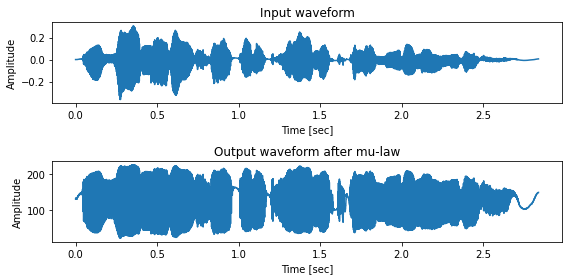
レシピの stage 3 の実行¶
上記の処理を行うバッチ処理のプログラムは、preprocess_wavenet.py にあります。
[29]:
if run_sh:
! ./run.sh --stage 3 --stop-stage 3 --n-jobs $n_jobs
特徴量の正規化¶
正規化のための統計量を計算するコマンドラインプログラムは、 recipes/common/fit_scaler.py を参照してください。また、正規化を行うコマンドラインプログラムは、 recipes/common/preprocess_normalize.py を参照してください。
レシピの stage 4 の実行¶
[30]:
if run_sh:
! ./run.sh --stage 4 --stop-stage 4 --n-jobs $n_jobs
正規化の処理の結果の確認¶
[31]:
# 言語特徴量の正規化前後
in_feats = np.load(f"dump/jsut_sr16000/org/train/in_logf0/{train_utt}-feats.npy")
in_feats_norm = np.load(f"dump/jsut_sr16000/norm/train/in_logf0/{train_utt}-feats.npy")
fig, ax = plt.subplots(2, 1, figsize=(8,6))
ax[0].set_title("Linguistic features (before normalization)")
ax[1].set_title("Linguistic features (after normalization)")
hop_length = int(sr * 0.005)
mesh = librosa.display.specshow(
in_feats.T, sr=sr, hop_length=hop_length, x_axis="time", y_axis="frames", ax=ax[0], cmap=cmap)
fig.colorbar(mesh, ax=ax[0])
mesh = librosa.display.specshow(
in_feats_norm.T, sr=sr, hop_length=hop_length, x_axis="time", y_axis="frames",ax=ax[1], cmap=cmap)
# NOTE: 実際には [-4, 4]の範囲外の値もありますが、視認性のために [-4, 4]に設定します
mesh.set_clim(-4, 4)
fig.colorbar(mesh, ax=ax[1])
for a in ax:
a.set_xlabel("Time [sec]")
a.set_ylabel("Context")
# 末尾の非音声区間を除く
a.set_xlim(0, 2.55)
plt.tight_layout()
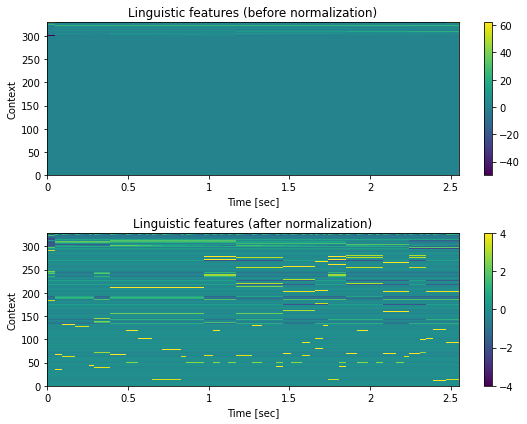
8.3 継続長モデルの学習¶
継続長モデルの設定ファイル¶
[32]:
! cat conf/train_dnntts/model/{duration_config_name}.yaml
netG:
_target_: ttslearn.dnntts.LSTMRNN
in_dim: 325
out_dim: 1
hidden_dim: 64
bidirectional: False
num_layers: 2
dropout: 0.5
stream_sizes: [1]
has_dynamic_features: [false]
継続長モデルのインスタンス化¶
[33]:
import hydra
from omegaconf import OmegaConf
hydra.utils.instantiate(OmegaConf.load(f"conf/train_dnntts/model/{duration_config_name}.yaml").netG)
[33]:
LSTMRNN(
(lstm): LSTM(325, 64, num_layers=2, batch_first=True, dropout=0.5)
(hidden2out): Linear(in_features=64, out_features=1, bias=True)
)
レシピの stage 5 の実行¶
[34]:
if run_sh:
! ./run.sh --stage 5 --stop-stage 5 --duration-model $duration_config_name \
--tqdm $run_sh_tqdm --dnntts-data-batch-size $dnntts_batch_size --dnntts-train-nepochs $dnntts_nepochs \
--cudnn-benchmark $cudnn_benchmark --cudnn-deterministic $cudnn_deterministic
損失関数の値の推移¶
著者による実験結果です。Tensorboardのログは https://tensorboard.dev/ にアップロードされています。 ログデータをtensorboard パッケージを利用してダウンロードします。
https://tensorboard.dev/experiment/yXyg9qgfQRSGxvil5FA4xw/
[35]:
if exists("tensorboard/all_log.csv"):
df = pd.read_csv("tensorboard/all_log.csv")
else:
experiment_id = "yXyg9qgfQRSGxvil5FA4xw"
experiment = tb.data.experimental.ExperimentFromDev(experiment_id)
df = experiment.get_scalars()
df.to_csv("tensorboard/all_log.csv", index=False)
df["run"].unique()
[35]:
array(['jsut_sr16000_duration_rnn', 'jsut_sr16000_logf0_rnn',
'jsut_sr16000_wavenet_sr16k_mulaw256'], dtype=object)
[36]:
duration_loss = df[df.run.str.contains("duration")]
duration_train_loss = duration_loss[duration_loss.tag.str.contains("Loss/train")]
duration_dev_loss = duration_loss[duration_loss.tag.str.contains("Loss/dev")]
fig, ax = plt.subplots(figsize=(6,4))
ax.plot(duration_train_loss["step"], duration_train_loss["value"], label="Train")
ax.plot(duration_dev_loss["step"], duration_dev_loss["value"], "--", label="Dev")
ax.set_xlabel("Epoch")
ax.set_ylabel("Epoch loss")
plt.legend()
# 図8-3
savefig("fig/wavenet_impl_duration_loss")
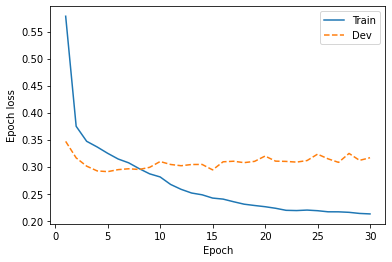
8.4 対数 F0 予測モデルの学習¶
対数 F0 予測モデルの設定ファイル¶
[37]:
! cat conf/train_dnntts/model/{logf0_config_name}.yaml
netG:
_target_: ttslearn.dnntts.LSTMRNN
in_dim: 329
out_dim: 4
hidden_dim: 64
bidirectional: True
num_layers: 2
dropout: 0.5
# (lf0, vuv)
stream_sizes: [3, 1]
has_dynamic_features: [true, false]
num_windows: 3
対数 F0 予測モデルのインスタンス化¶
[38]:
import hydra
from omegaconf import OmegaConf
hydra.utils.instantiate(OmegaConf.load(f"conf/train_dnntts/model/{logf0_config_name}.yaml").netG)
[38]:
LSTMRNN(
(lstm): LSTM(329, 64, num_layers=2, batch_first=True, dropout=0.5, bidirectional=True)
(hidden2out): Linear(in_features=128, out_features=4, bias=True)
)
レシピの stage 6 の実行¶
[39]:
if run_sh:
! ./run.sh --stage 6 --stop-stage 6 --logf0-model $logf0_config_name \
--tqdm $run_sh_tqdm --dnntts-data-batch-size $dnntts_batch_size --dnntts-train-nepochs $dnntts_nepochs \
--cudnn-benchmark $cudnn_benchmark --cudnn-deterministic $cudnn_deterministic
損失関数の値の推移¶
[40]:
logf0_loss = df[df.run.str.contains("logf0")]
logf0_train_loss = logf0_loss[logf0_loss.tag.str.contains("Loss/train")]
logf0_dev_loss = logf0_loss[logf0_loss.tag.str.contains("Loss/dev")]
fig, ax = plt.subplots(figsize=(6,4))
ax.plot(logf0_train_loss["step"], logf0_train_loss["value"], label="Train")
ax.plot(logf0_dev_loss["step"], logf0_dev_loss["value"], "--", label="Dev")
ax.set_xlabel("Epoch")
ax.set_ylabel("Epoch loss")
plt.legend()
# 図8-4
savefig("fig/wavenet_impl_logf0_loss")
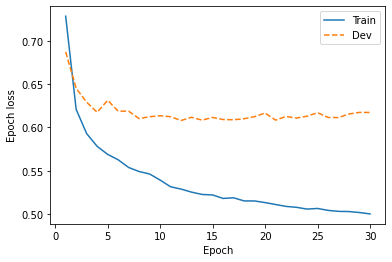
8.5 WaveNet の学習スクリプトの実装¶
DataLoaderの実装¶
collate_fn の実装¶
[41]:
def collate_fn_wavenet(batch, max_time_frames=100, hop_size=80, aux_context_window=2):
max_time_steps = max_time_frames * hop_size
xs, cs = [b[1] for b in batch], [b[0] for b in batch]
# 条件付け特徴量の開始位置をランダム抽出した後、それに相当する短い音声波形を切り出します
c_lengths = [len(c) for c in cs]
start_frames = np.array(
[
np.random.randint(
aux_context_window, cl - aux_context_window - max_time_frames
)
for cl in c_lengths
]
)
x_starts = start_frames * hop_size
x_ends = x_starts + max_time_steps
c_starts = start_frames - aux_context_window
c_ends = start_frames + max_time_frames + aux_context_window
x_batch = [x[s:e] for x, s, e in zip(xs, x_starts, x_ends)]
c_batch = [c[s:e] for c, s, e in zip(cs, c_starts, c_ends)]
# numpy.ndarray のリスト型から torch.Tensor 型に変換します
x_batch = torch.tensor(x_batch, dtype=torch.long) # (B, T)
c_batch = torch.tensor(c_batch, dtype=torch.float).transpose(2, 1) # (B, C, T')
return x_batch, c_batch
DataLoader の利用例¶
[42]:
from pathlib import Path
from ttslearn.train_util import Dataset
from functools import partial
in_paths = sorted(Path("./dump/jsut_sr16000/norm/dev/in_wavenet/").glob("*.npy"))
out_paths = sorted(Path("./dump/jsut_sr16000/org/dev/out_wavenet/").glob("*.npy"))
dataset = Dataset(in_paths, out_paths)
collate_fn = partial(collate_fn_wavenet, max_time_frames=100, hop_size=80, aux_context_window=0)
data_loader = torch.utils.data.DataLoader(dataset, batch_size=8, collate_fn=collate_fn, num_workers=0)
wavs, feats = next(iter(data_loader))
print("音声波形のサイズ:", tuple(wavs.shape))
print("条件付け特徴量のサイズ:", tuple(feats.shape))
音声波形のサイズ: (8, 8000)
条件付け特徴量のサイズ: (8, 333, 100)
ミニバッチの可視化¶
[43]:
from ttslearn.dsp import inv_mulaw_quantize
fig, ax = plt.subplots(len(wavs), 1, figsize=(8,10), sharex=True, sharey=True)
for n in range(len(wavs)):
x = wavs[n].data.numpy()
x = inv_mulaw_quantize(x, 255)
ax[n].plot(x)
ax[-1].set_xlabel("Time [sample]")
for a in ax:
a.set_ylabel("Amplitude")
plt.tight_layout()
# 図8-5
savefig("fig/wavenet_impl_minibatch")
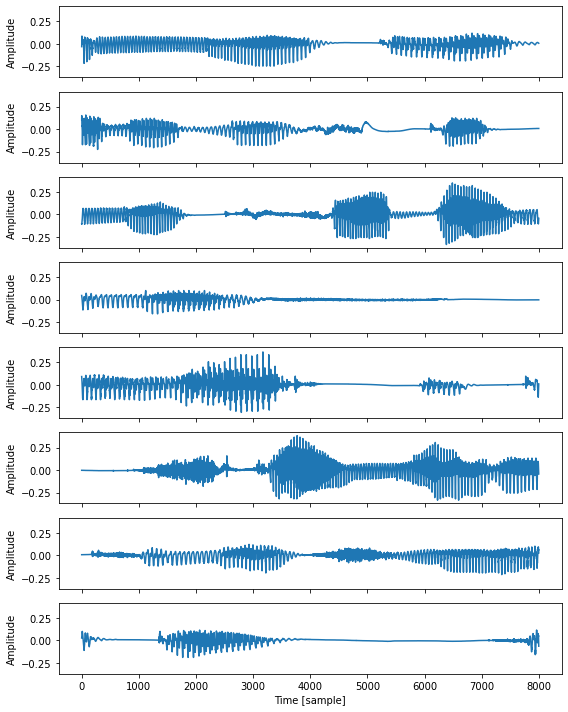
簡易的な学習スクリプトの実装¶
モデルパラメータの指数移動平均¶
[44]:
def moving_average_(model, model_test, beta=0.9999):
for param, param_test in zip(model.parameters(), model_test.parameters()):
param_test.data = torch.lerp(param.data, param_test.data, beta)
学習の前準備¶
[45]:
from ttslearn.wavenet import WaveNet
from torch import optim
# 動作確認用:層の数を減らした小さなWaveNet
ToyWaveNet = partial(WaveNet, out_channels=256, layers=2, stacks=1, kernel_size=2, cin_channels=333)
model = ToyWaveNet()
# モデルパラメータの指数移動平均
model_ema = ToyWaveNet()
model_ema.load_state_dict(model.state_dict())
# lr は学習率を表します
optimizer = optim.Adam(model.parameters(), lr=0.01)
# gamma は学習率の減衰係数を表します
lr_scheduler = optim.lr_scheduler.StepLR(optimizer, gamma=0.5, step_size=100000)
学習ループの実装¶
[46]:
# DataLoader を用いたミニバッチの作成: ミニバッチ毎に処理を行う
for x, c in data_loader:
# 順伝播の計算
x_hat = model(x, c)
# 負の対数尤度の計算
loss = nn.CrossEntropyLoss()(x_hat[:, :, :-1], x[:, 1:]).mean()
# 損失の値を出力
print(loss.item())
# optimizer に蓄積された勾配をリセット
optimizer.zero_grad()
# 誤差の逆伝播の計算
loss.backward()
# パラメータの更新
optimizer.step()
# 移動指数平均の計算
moving_average_(model, model_ema)
# 学習率スケジューラの更新
lr_scheduler.step()
5.545470237731934
5.515237808227539
5.40777587890625
5.302576541900635
5.261532306671143
5.220343112945557
5.135021209716797
5.155230522155762
5.145912170410156
5.041654109954834
5.049261569976807
5.014197826385498
4.965615749359131
4.921651363372803
4.888494491577148
4.876847267150879
4.818419456481934
4.703741550445557
4.72671365737915
4.643199920654297
4.637485504150391
4.51542329788208
4.59623908996582
4.423515319824219
4.415907859802246
実用的な学習スクリプトの実装¶
train_wavenet.py を参照してください。
8.6 WaveNet の学習¶
WaveNet の設定ファイル¶
[47]:
! cat conf/train_wavenet/model/{wavenet_config_name}.yaml
netG:
_target_: ttslearn.wavenet.WaveNet
out_channels: 256
layers: 30
stacks: 3
residual_channels: 64
gate_channels: 128
skip_out_channels: 64
kernel_size: 3
cin_channels: 333 # 329 (linguistic features) + 4 (logf0 + vuv)
upsample_scales: [2, 4, 2, 5] # np.prod(upsample_scales) = 80
aux_context_window: 2
WaveNet のインスタンス化¶
[48]:
import hydra
from omegaconf import OmegaConf
# WaveNet の 30層 すべてを表示すると長くなるため、ここでは省略します。
# hydra.utils.instantiate(OmegaConf.load(f"./conf/train_wavenet/model/{wavenet_config_name}.yaml")["netG"])
レシピの stage 7 の実行¶
[49]:
if run_sh:
! ./run.sh --stage 7 --stop-stage 7 --wavenet-model $wavenet_config_name \
--tqdm $run_sh_tqdm --wavenet-data-batch-size $wavenet_batch_size --wavenet-train-max-train-steps $wavenet_max_train_steps \
--cudnn-benchmark $cudnn_benchmark --cudnn-deterministic $cudnn_deterministic
損失関数の値の推移¶
[50]:
wavenet_loss = df[df.run.str.contains("wavenet")]
wavenet_train_loss = wavenet_loss[wavenet_loss.tag.str.contains("Loss/train")]
wavenet_dev_loss = wavenet_loss[wavenet_loss.tag.str.contains("Loss/dev")]
fig, ax = plt.subplots(figsize=(6,4))
ax.plot(wavenet_train_loss["step"], wavenet_train_loss["value"], label="Train")
ax.plot(wavenet_dev_loss["step"], wavenet_dev_loss["value"], "--", label="Dev")
ax.set_xlabel("Epoch")
ax.set_ylabel("Epoch loss")
ax.set_ylim(1.7, 2.2)
plt.legend()
# 図8-6
savefig("fig/wavenet_impl_wavenet_loss")
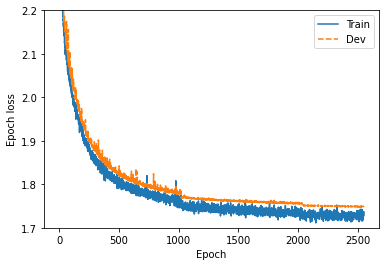
8.7 学習済みモデルを用いてテキストから音声を合成¶
学習済みモデルの読み込み¶
[51]:
import joblib
device = torch.device("cpu")
継続長モデルの読み込み¶
[52]:
duration_config = OmegaConf.load(f"exp/jsut_sr16000/{duration_config_name}/model.yaml")
duration_model = hydra.utils.instantiate(duration_config.netG)
checkpoint = torch.load(f"exp/jsut_sr16000/{duration_config_name}/latest.pth", map_location=device)
duration_model.load_state_dict(checkpoint["state_dict"])
duration_model.eval();
[52]:
LSTMRNN(
(lstm): LSTM(325, 64, num_layers=2, batch_first=True, dropout=0.5)
(hidden2out): Linear(in_features=64, out_features=1, bias=True)
)
対数F0予測モデルの読み込み¶
[53]:
logf0_config = OmegaConf.load(f"exp/jsut_sr16000/{logf0_config_name}/model.yaml")
logf0_model = hydra.utils.instantiate(logf0_config.netG)
checkpoint = torch.load(f"exp/jsut_sr16000/{logf0_config_name}/latest.pth", map_location=device)
logf0_model.load_state_dict(checkpoint["state_dict"])
logf0_model.eval();
[53]:
LSTMRNN(
(lstm): LSTM(329, 64, num_layers=2, batch_first=True, dropout=0.5, bidirectional=True)
(hidden2out): Linear(in_features=128, out_features=4, bias=True)
)
WaveNetの読み込み¶
[54]:
wavenet_config = OmegaConf.load(f"exp/jsut_sr16000/{wavenet_config_name}/model.yaml")
wavenet_model = hydra.utils.instantiate(wavenet_config.netG)
checkpoint = torch.load(f"exp/jsut_sr16000/{wavenet_config_name}/latest_ema.pth", map_location=device)
wavenet_model.load_state_dict(checkpoint["state_dict"])
# weight normalization は推論時には不要なため除く
wavenet_model.remove_weight_norm_()
wavenet_model.eval();
[54]:
WaveNet(
(first_conv): Conv1d(256, 64, kernel_size=(1,), stride=(1,))
(main_conv_layers): ModuleList(
(0): ResSkipBlock(
(conv): Conv1d(64, 128, kernel_size=(3,), stride=(1,), padding=(2,))
(conv1x1c): Conv1d(333, 128, kernel_size=(1,), stride=(1,), bias=False)
(conv1x1_out): Conv1d(64, 64, kernel_size=(1,), stride=(1,))
(conv1x1_skip): Conv1d(64, 64, kernel_size=(1,), stride=(1,))
)
(1): ResSkipBlock(
(conv): Conv1d(64, 128, kernel_size=(3,), stride=(1,), padding=(4,), dilation=(2,))
(conv1x1c): Conv1d(333, 128, kernel_size=(1,), stride=(1,), bias=False)
(conv1x1_out): Conv1d(64, 64, kernel_size=(1,), stride=(1,))
(conv1x1_skip): Conv1d(64, 64, kernel_size=(1,), stride=(1,))
)
(2): ResSkipBlock(
(conv): Conv1d(64, 128, kernel_size=(3,), stride=(1,), padding=(8,), dilation=(4,))
(conv1x1c): Conv1d(333, 128, kernel_size=(1,), stride=(1,), bias=False)
(conv1x1_out): Conv1d(64, 64, kernel_size=(1,), stride=(1,))
(conv1x1_skip): Conv1d(64, 64, kernel_size=(1,), stride=(1,))
)
(3): ResSkipBlock(
(conv): Conv1d(64, 128, kernel_size=(3,), stride=(1,), padding=(16,), dilation=(8,))
(conv1x1c): Conv1d(333, 128, kernel_size=(1,), stride=(1,), bias=False)
(conv1x1_out): Conv1d(64, 64, kernel_size=(1,), stride=(1,))
(conv1x1_skip): Conv1d(64, 64, kernel_size=(1,), stride=(1,))
)
(4): ResSkipBlock(
(conv): Conv1d(64, 128, kernel_size=(3,), stride=(1,), padding=(32,), dilation=(16,))
(conv1x1c): Conv1d(333, 128, kernel_size=(1,), stride=(1,), bias=False)
(conv1x1_out): Conv1d(64, 64, kernel_size=(1,), stride=(1,))
(conv1x1_skip): Conv1d(64, 64, kernel_size=(1,), stride=(1,))
)
(5): ResSkipBlock(
(conv): Conv1d(64, 128, kernel_size=(3,), stride=(1,), padding=(64,), dilation=(32,))
(conv1x1c): Conv1d(333, 128, kernel_size=(1,), stride=(1,), bias=False)
(conv1x1_out): Conv1d(64, 64, kernel_size=(1,), stride=(1,))
(conv1x1_skip): Conv1d(64, 64, kernel_size=(1,), stride=(1,))
)
(6): ResSkipBlock(
(conv): Conv1d(64, 128, kernel_size=(3,), stride=(1,), padding=(128,), dilation=(64,))
(conv1x1c): Conv1d(333, 128, kernel_size=(1,), stride=(1,), bias=False)
(conv1x1_out): Conv1d(64, 64, kernel_size=(1,), stride=(1,))
(conv1x1_skip): Conv1d(64, 64, kernel_size=(1,), stride=(1,))
)
(7): ResSkipBlock(
(conv): Conv1d(64, 128, kernel_size=(3,), stride=(1,), padding=(256,), dilation=(128,))
(conv1x1c): Conv1d(333, 128, kernel_size=(1,), stride=(1,), bias=False)
(conv1x1_out): Conv1d(64, 64, kernel_size=(1,), stride=(1,))
(conv1x1_skip): Conv1d(64, 64, kernel_size=(1,), stride=(1,))
)
(8): ResSkipBlock(
(conv): Conv1d(64, 128, kernel_size=(3,), stride=(1,), padding=(512,), dilation=(256,))
(conv1x1c): Conv1d(333, 128, kernel_size=(1,), stride=(1,), bias=False)
(conv1x1_out): Conv1d(64, 64, kernel_size=(1,), stride=(1,))
(conv1x1_skip): Conv1d(64, 64, kernel_size=(1,), stride=(1,))
)
(9): ResSkipBlock(
(conv): Conv1d(64, 128, kernel_size=(3,), stride=(1,), padding=(1024,), dilation=(512,))
(conv1x1c): Conv1d(333, 128, kernel_size=(1,), stride=(1,), bias=False)
(conv1x1_out): Conv1d(64, 64, kernel_size=(1,), stride=(1,))
(conv1x1_skip): Conv1d(64, 64, kernel_size=(1,), stride=(1,))
)
(10): ResSkipBlock(
(conv): Conv1d(64, 128, kernel_size=(3,), stride=(1,), padding=(2,))
(conv1x1c): Conv1d(333, 128, kernel_size=(1,), stride=(1,), bias=False)
(conv1x1_out): Conv1d(64, 64, kernel_size=(1,), stride=(1,))
(conv1x1_skip): Conv1d(64, 64, kernel_size=(1,), stride=(1,))
)
(11): ResSkipBlock(
(conv): Conv1d(64, 128, kernel_size=(3,), stride=(1,), padding=(4,), dilation=(2,))
(conv1x1c): Conv1d(333, 128, kernel_size=(1,), stride=(1,), bias=False)
(conv1x1_out): Conv1d(64, 64, kernel_size=(1,), stride=(1,))
(conv1x1_skip): Conv1d(64, 64, kernel_size=(1,), stride=(1,))
)
(12): ResSkipBlock(
(conv): Conv1d(64, 128, kernel_size=(3,), stride=(1,), padding=(8,), dilation=(4,))
(conv1x1c): Conv1d(333, 128, kernel_size=(1,), stride=(1,), bias=False)
(conv1x1_out): Conv1d(64, 64, kernel_size=(1,), stride=(1,))
(conv1x1_skip): Conv1d(64, 64, kernel_size=(1,), stride=(1,))
)
(13): ResSkipBlock(
(conv): Conv1d(64, 128, kernel_size=(3,), stride=(1,), padding=(16,), dilation=(8,))
(conv1x1c): Conv1d(333, 128, kernel_size=(1,), stride=(1,), bias=False)
(conv1x1_out): Conv1d(64, 64, kernel_size=(1,), stride=(1,))
(conv1x1_skip): Conv1d(64, 64, kernel_size=(1,), stride=(1,))
)
(14): ResSkipBlock(
(conv): Conv1d(64, 128, kernel_size=(3,), stride=(1,), padding=(32,), dilation=(16,))
(conv1x1c): Conv1d(333, 128, kernel_size=(1,), stride=(1,), bias=False)
(conv1x1_out): Conv1d(64, 64, kernel_size=(1,), stride=(1,))
(conv1x1_skip): Conv1d(64, 64, kernel_size=(1,), stride=(1,))
)
(15): ResSkipBlock(
(conv): Conv1d(64, 128, kernel_size=(3,), stride=(1,), padding=(64,), dilation=(32,))
(conv1x1c): Conv1d(333, 128, kernel_size=(1,), stride=(1,), bias=False)
(conv1x1_out): Conv1d(64, 64, kernel_size=(1,), stride=(1,))
(conv1x1_skip): Conv1d(64, 64, kernel_size=(1,), stride=(1,))
)
(16): ResSkipBlock(
(conv): Conv1d(64, 128, kernel_size=(3,), stride=(1,), padding=(128,), dilation=(64,))
(conv1x1c): Conv1d(333, 128, kernel_size=(1,), stride=(1,), bias=False)
(conv1x1_out): Conv1d(64, 64, kernel_size=(1,), stride=(1,))
(conv1x1_skip): Conv1d(64, 64, kernel_size=(1,), stride=(1,))
)
(17): ResSkipBlock(
(conv): Conv1d(64, 128, kernel_size=(3,), stride=(1,), padding=(256,), dilation=(128,))
(conv1x1c): Conv1d(333, 128, kernel_size=(1,), stride=(1,), bias=False)
(conv1x1_out): Conv1d(64, 64, kernel_size=(1,), stride=(1,))
(conv1x1_skip): Conv1d(64, 64, kernel_size=(1,), stride=(1,))
)
(18): ResSkipBlock(
(conv): Conv1d(64, 128, kernel_size=(3,), stride=(1,), padding=(512,), dilation=(256,))
(conv1x1c): Conv1d(333, 128, kernel_size=(1,), stride=(1,), bias=False)
(conv1x1_out): Conv1d(64, 64, kernel_size=(1,), stride=(1,))
(conv1x1_skip): Conv1d(64, 64, kernel_size=(1,), stride=(1,))
)
(19): ResSkipBlock(
(conv): Conv1d(64, 128, kernel_size=(3,), stride=(1,), padding=(1024,), dilation=(512,))
(conv1x1c): Conv1d(333, 128, kernel_size=(1,), stride=(1,), bias=False)
(conv1x1_out): Conv1d(64, 64, kernel_size=(1,), stride=(1,))
(conv1x1_skip): Conv1d(64, 64, kernel_size=(1,), stride=(1,))
)
(20): ResSkipBlock(
(conv): Conv1d(64, 128, kernel_size=(3,), stride=(1,), padding=(2,))
(conv1x1c): Conv1d(333, 128, kernel_size=(1,), stride=(1,), bias=False)
(conv1x1_out): Conv1d(64, 64, kernel_size=(1,), stride=(1,))
(conv1x1_skip): Conv1d(64, 64, kernel_size=(1,), stride=(1,))
)
(21): ResSkipBlock(
(conv): Conv1d(64, 128, kernel_size=(3,), stride=(1,), padding=(4,), dilation=(2,))
(conv1x1c): Conv1d(333, 128, kernel_size=(1,), stride=(1,), bias=False)
(conv1x1_out): Conv1d(64, 64, kernel_size=(1,), stride=(1,))
(conv1x1_skip): Conv1d(64, 64, kernel_size=(1,), stride=(1,))
)
(22): ResSkipBlock(
(conv): Conv1d(64, 128, kernel_size=(3,), stride=(1,), padding=(8,), dilation=(4,))
(conv1x1c): Conv1d(333, 128, kernel_size=(1,), stride=(1,), bias=False)
(conv1x1_out): Conv1d(64, 64, kernel_size=(1,), stride=(1,))
(conv1x1_skip): Conv1d(64, 64, kernel_size=(1,), stride=(1,))
)
(23): ResSkipBlock(
(conv): Conv1d(64, 128, kernel_size=(3,), stride=(1,), padding=(16,), dilation=(8,))
(conv1x1c): Conv1d(333, 128, kernel_size=(1,), stride=(1,), bias=False)
(conv1x1_out): Conv1d(64, 64, kernel_size=(1,), stride=(1,))
(conv1x1_skip): Conv1d(64, 64, kernel_size=(1,), stride=(1,))
)
(24): ResSkipBlock(
(conv): Conv1d(64, 128, kernel_size=(3,), stride=(1,), padding=(32,), dilation=(16,))
(conv1x1c): Conv1d(333, 128, kernel_size=(1,), stride=(1,), bias=False)
(conv1x1_out): Conv1d(64, 64, kernel_size=(1,), stride=(1,))
(conv1x1_skip): Conv1d(64, 64, kernel_size=(1,), stride=(1,))
)
(25): ResSkipBlock(
(conv): Conv1d(64, 128, kernel_size=(3,), stride=(1,), padding=(64,), dilation=(32,))
(conv1x1c): Conv1d(333, 128, kernel_size=(1,), stride=(1,), bias=False)
(conv1x1_out): Conv1d(64, 64, kernel_size=(1,), stride=(1,))
(conv1x1_skip): Conv1d(64, 64, kernel_size=(1,), stride=(1,))
)
(26): ResSkipBlock(
(conv): Conv1d(64, 128, kernel_size=(3,), stride=(1,), padding=(128,), dilation=(64,))
(conv1x1c): Conv1d(333, 128, kernel_size=(1,), stride=(1,), bias=False)
(conv1x1_out): Conv1d(64, 64, kernel_size=(1,), stride=(1,))
(conv1x1_skip): Conv1d(64, 64, kernel_size=(1,), stride=(1,))
)
(27): ResSkipBlock(
(conv): Conv1d(64, 128, kernel_size=(3,), stride=(1,), padding=(256,), dilation=(128,))
(conv1x1c): Conv1d(333, 128, kernel_size=(1,), stride=(1,), bias=False)
(conv1x1_out): Conv1d(64, 64, kernel_size=(1,), stride=(1,))
(conv1x1_skip): Conv1d(64, 64, kernel_size=(1,), stride=(1,))
)
(28): ResSkipBlock(
(conv): Conv1d(64, 128, kernel_size=(3,), stride=(1,), padding=(512,), dilation=(256,))
(conv1x1c): Conv1d(333, 128, kernel_size=(1,), stride=(1,), bias=False)
(conv1x1_out): Conv1d(64, 64, kernel_size=(1,), stride=(1,))
(conv1x1_skip): Conv1d(64, 64, kernel_size=(1,), stride=(1,))
)
(29): ResSkipBlock(
(conv): Conv1d(64, 128, kernel_size=(3,), stride=(1,), padding=(1024,), dilation=(512,))
(conv1x1c): Conv1d(333, 128, kernel_size=(1,), stride=(1,), bias=False)
(conv1x1_out): Conv1d(64, 64, kernel_size=(1,), stride=(1,))
(conv1x1_skip): Conv1d(64, 64, kernel_size=(1,), stride=(1,))
)
)
(last_conv_layers): ModuleList(
(0): ReLU()
(1): Conv1d(64, 64, kernel_size=(1,), stride=(1,))
(2): ReLU()
(3): Conv1d(64, 256, kernel_size=(1,), stride=(1,))
)
(upsample_net): ConvInUpsampleNetwork(
(conv_in): Conv1d(333, 333, kernel_size=(5,), stride=(1,), bias=False)
(upsample): UpsampleNetwork(
(conv_layers): ModuleList(
(0): Conv2d(1, 1, kernel_size=(1, 5), stride=(1, 1), padding=(0, 2), bias=False)
(1): Conv2d(1, 1, kernel_size=(1, 9), stride=(1, 1), padding=(0, 4), bias=False)
(2): Conv2d(1, 1, kernel_size=(1, 5), stride=(1, 1), padding=(0, 2), bias=False)
(3): Conv2d(1, 1, kernel_size=(1, 11), stride=(1, 1), padding=(0, 5), bias=False)
)
)
)
)
統計量の読み込み¶
[55]:
duration_in_scaler = joblib.load("./dump/jsut_sr16000/norm/in_duration_scaler.joblib")
duration_out_scaler = joblib.load("./dump/jsut_sr16000/norm/out_duration_scaler.joblib")
logf0_in_scaler = joblib.load("./dump/jsut_sr16000/norm/in_logf0_scaler.joblib")
logf0_out_scaler = joblib.load("./dump/jsut_sr16000/norm/out_logf0_scaler.joblib")
wavenet_in_scaler = joblib.load("./dump/jsut_sr16000/norm/in_wavenet_scaler.joblib")
音素継続長の予測¶
[56]:
from ttslearn.util import lab2phonemes, find_lab, find_feats
from ttslearn.dnntts.gen import predict_duration
labels = hts.load(find_lab("downloads/jsut_ver1.1/", test_utt))
# フルコンテキストラベルから音素のみを抽出
test_phonemes = lab2phonemes(labels)
# 言語特徴量の抽出に使うための質問ファイル
binary_dict, numeric_dict = hts.load_question_set(ttslearn.util.example_qst_file())
# 音素継続長の予測
durations_test = predict_duration(
device, labels, duration_model, duration_config, duration_in_scaler, duration_out_scaler,
binary_dict, numeric_dict)
durations_test_target = np.load(find_feats("dump/jsut_sr16000/org", test_utt, typ="out_duration"))
fig, ax = plt.subplots(1,1, figsize=(6,4))
ax.plot(durations_test_target, "-+", label="Target")
ax.plot(durations_test, "--*", label="Predicted")
ax.set_xticks(np.arange(len(test_phonemes)))
ax.set_xticklabels(test_phonemes)
ax.set_xlabel("Phoneme")
ax.set_ylabel("Duration (the number of frames)")
ax.legend()
plt.tight_layout()
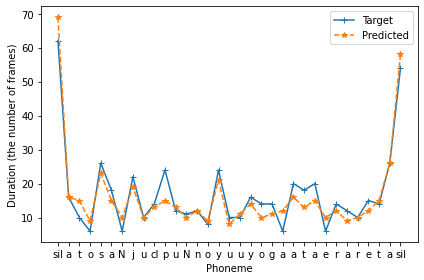
対数基本周波数の予測¶
[57]:
from ttslearn.dnntts.gen import predict_acoustic
labels = hts.load(find_lab("downloads/jsut_ver1.1/", test_utt))
# 対数基本周波数の予測
out_feats = predict_acoustic(
device, labels, logf0_model, logf0_config, logf0_in_scaler,
logf0_out_scaler, binary_dict, numeric_dict)
[58]:
from ttslearn.util import trim_silence
from ttslearn.dnntts.multistream import split_streams
# 結合された特徴量を分離
out_feats = trim_silence(out_feats, labels)
lf0_gen, vuv_gen = out_feats[:, 0], out_feats[:, 1]
[59]:
from ttslearn.dnntts.multistream import get_static_features
# 比較用に、自然音声から抽出された音響特徴量を読み込みむ
feats = np.load(find_feats("dump/jsut_sr16000/org/", test_utt, typ="out_logf0"))
# 特徴量の分離
lf0_ref, vuv_ref = get_static_features(
feats, logf0_config.num_windows, logf0_config.stream_sizes, logf0_config.has_dynamic_features)
F0の可視化¶
[60]:
# 対数基本周波数から基本周波数への変換
f0_ref = np.exp(lf0_ref)
f0_ref[vuv_ref < 0.5] = 0
f0_gen = np.exp(lf0_gen)
f0_gen[vuv_gen < 0.5] = 0
timeaxis = librosa.frames_to_time(np.arange(len(f0_ref)), sr=sr, hop_length=int(0.005 * sr))
fix, ax = plt.subplots(1,1, figsize=(8,3))
ax.plot(timeaxis, f0_ref, linewidth=2, label="F0 of natural speech")
ax.plot(timeaxis, f0_gen, "--", linewidth=2, label="F0 of generated speech")
ax.set_xlabel("Time [sec]")
ax.set_ylabel("Frequency [Hz]")
ax.set_xlim(timeaxis[0], timeaxis[-1])
plt.legend()
plt.tight_layout()
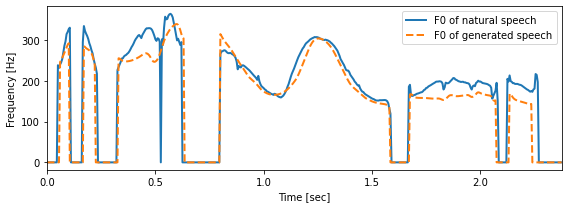
音声波形の生成¶
[61]:
from ttslearn.dsp import inv_mulaw_quantize
@torch.no_grad()
def gen_waveform(
device, # cpu or cuda
labels, # フルコンテキストラベル
logf0_vuv, # 連続対数基本周波数と有声/無声フラグ
wavenet_model, # 学習済み WaveNet
wavenet_in_scaler, # 条件付け特徴量の正規化用 StandardScaler
binary_dict, # 二値特徴量を抽出する正規表現
numeric_dict, # 数値特徴量を抽出する正規表現
tqdm=tqdm, # プログレスバー
):
# フレーム単位の言語特徴量の抽出
in_feats = fe.linguistic_features(
labels,
binary_dict,
numeric_dict,
add_frame_features=True,
subphone_features="coarse_coding",
)
# フレーム単位の言語特徴量と、対数連続基本周波数・有声/無声フラグを結合
in_feats = np.hstack([in_feats, logf0_vuv])
# 特徴量の正規化
in_feats = wavenet_in_scaler.transform(in_feats)
# 条件付け特徴量を numpy.ndarray から torch.Tensor に変換
c = torch.from_numpy(in_feats).float().to(device)
# (B, T, C) -> (B, C, T)
c = c.view(1, -1, c.size(-1)).transpose(1, 2)
# 音声波形の長さを計算
upsample_scale = np.prod(wavenet_model.upsample_scales)
time_steps = (c.shape[-1] - wavenet_model.aux_context_window * 2) * upsample_scale
# WaveNet による音声波形の生成
# NOTE: 計算に時間を要するため、tqdm によるプログレスバーを利用します
gen_wav = wavenet_model.inference(c, time_steps, tqdm)
# One-hot ベクトルから 1 次元の信号に変換
gen_wav = gen_wav.max(1)[1].float().cpu().numpy().reshape(-1)
# Mu-law 量子化の逆変換
gen_wav = inv_mulaw_quantize(gen_wav, wavenet_model.out_channels - 1)
return gen_wav
すべてのモデルを組み合わせて音声波形の生成¶
[62]:
# NOTE: False の場合、正解のdurationsを使います
# すべてのモデルを連結する場合、True にしてください
use_ground_truth_durations = True
labels = hts.load(find_lab("downloads/jsut_ver1.1/", test_utt))
# 言語特徴量の抽出の下準備
binary_dict, numeric_dict = hts.load_question_set(ttslearn.util.example_qst_file())
if not use_ground_truth_durations:
# 音素継続長の予測
durations = predict_duration(
device, labels, duration_model, duration_config, duration_in_scaler, duration_out_scaler,
binary_dict, numeric_dict)
# 予測された継続長をフルコンテキストラベルに設定
labels.set_durations(durations)
# 対数基本周波数の予測
# NOTE: 動的特徴量をWaveNetの条件付け特徴量に用いるため、パラメータ生成 (mlpg) は行わない
logf0_vuv = predict_acoustic(
device, labels, logf0_model, logf0_config, logf0_in_scaler,
logf0_out_scaler, binary_dict, numeric_dict, mlpg=False)
# WaveNetによる音声波形の生成
gen_wav = gen_waveform(
device, labels, logf0_vuv, wavenet_model, wavenet_in_scaler,
binary_dict, numeric_dict, tqdm)
[63]:
# 比較用に元音声の読み込み
from scipy.io import wavfile
_sr, ref_wav = wavfile.read(f"./downloads/jsut_ver1.1/basic5000/wav/{test_utt}.wav")
ref_wav = (ref_wav / 32768.0).astype(np.float64)
ref_wav = librosa.resample(ref_wav, _sr, sr)
[64]:
fig, ax = plt.subplots(2, 1, figsize=(8,6))
hop_length = int(sr * 0.005)
fft_size = pyworld.get_cheaptrick_fft_size(sr)
spec_ref = librosa.stft(ref_wav, n_fft=fft_size, hop_length=hop_length, window="hann")
logspec_ref = np.log(np.abs(spec_ref))
spec_gen = librosa.stft(gen_wav, n_fft=fft_size, hop_length=hop_length, window="hann")
logspec_gen = np.log(np.abs(spec_gen))
mindb = min(logspec_ref.min(), logspec_gen.min())
maxdb = max(logspec_ref.max(), logspec_gen.max())
mesh = librosa.display.specshow(logspec_ref, hop_length=hop_length, sr=sr, cmap=cmap, x_axis="time", y_axis="hz", ax=ax[0])
mesh.set_clim(mindb, maxdb)
fig.colorbar(mesh, ax=ax[0], format="%+2.fdB")
mesh = librosa.display.specshow(logspec_gen, hop_length=hop_length, sr=sr, cmap=cmap, x_axis="time", y_axis="hz", ax=ax[1])
mesh.set_clim(mindb, maxdb)
fig.colorbar(mesh, ax=ax[1], format="%+2.fdB")
ax[0].set_title("Spectrogram of natural speech")
ax[1].set_title("Spectrogram of generated speech")
for a in ax:
a.set_xlabel("Time [sec]")
a.set_ylabel("Frequency [Hz]")
plt.tight_layout()
print("自然音声")
IPython.display.display(Audio(ref_wav, rate=sr))
print("WaveNet音声合成")
IPython.display.display(Audio(gen_wav, rate=sr))
# 図8-7
savefig("./fig/wavenet_impl_tts_spec_comp")
自然音声
WaveNet音声合成
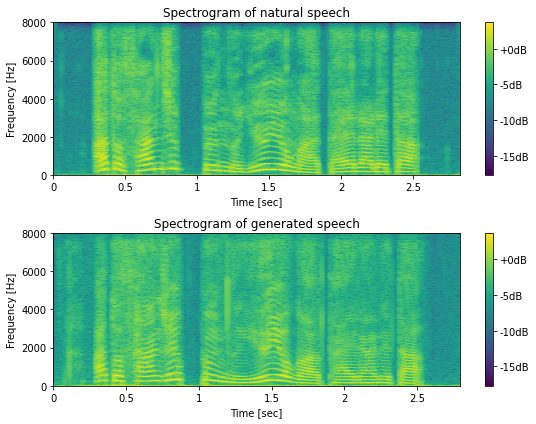
自然音声と合成音声の比較 (bonus)¶
[66]:
from pathlib import Path
from ttslearn.util import load_utt_list
with open("./downloads/jsut_ver1.1/basic5000/transcript_utf8.txt") as f:
transcripts = {}
for l in f:
utt_id, script = l.split(":")
transcripts[utt_id] = script
eval_list = load_utt_list("data/eval.list")[::-1][:5]
for utt_id in eval_list:
# ref file
ref_file = f"./downloads/jsut_ver1.1/basic5000/wav/{utt_id}.wav"
_sr, ref_wav = wavfile.read(ref_file)
ref_wav = (ref_wav / 32768.0).astype(np.float64)
ref_wav = librosa.resample(ref_wav, _sr, sr)
print(f"{utt_id}: {transcripts[utt_id]}")
print("自然音声")
IPython.display.display(Audio(ref_wav, rate=sr))
gen_file = f"exp/jsut_sr16000/synthesis_{duration_config_name}_{logf0_config_name}_{wavenet_config_name}/eval/{utt_id}.wav"
if exists(gen_file):
_sr, gen_wav = wavfile.read(gen_file)
print("WaveNet音声合成")
IPython.display.display(Audio(gen_wav, rate=sr))
else:
# 音声生成が完了していない場合
print("WaveNet音声合成: not found")
BASIC5000_5000: あと30分の猶予が与えられた。
自然音声
WaveNet音声合成
BASIC5000_4999: ドナーから腎臓の提供を受ける。
自然音声
WaveNet音声合成
BASIC5000_4998: 村人たちは、その話を聞いて、震え上がった。
自然音声
WaveNet音声合成
BASIC5000_4997: その王国は、最後の王に嗣子がおらず、滅亡した。
自然音声
WaveNet音声合成
BASIC5000_4996: 扇型の、弧の長さを、計算で求める。
自然音声
WaveNet音声合成
学習済みモデルのパッケージング (bonus)¶
学習済みモデルを利用したTTSに必要なファイルをすべて単一のディレクトリにまとめます。 ttslearn.wavenet.WaveNetTTS クラスには、まとめたディレクトリを指定し、TTSを行う機能が実装されています。
レシピの stage 99 の実行¶
[67]:
if run_sh:
! ./run.sh --stage 99 --stop-stage 99 \
--duration-model $duration_config_name --logf0-model $logf0_config_name --wavenet-model $wavenet_config_name
[68]:
!ls tts_models/jsut_sr16000_{duration_config_name}_{logf0_config_name}_{wavenet_config_name}
config.yaml logf0_model.pth
duration_model.pth logf0_model.yaml
duration_model.yaml out_duration_scaler_mean.npy
in_duration_scaler_mean.npy out_duration_scaler_scale.npy
in_duration_scaler_scale.npy out_duration_scaler_var.npy
in_duration_scaler_var.npy out_logf0_scaler_mean.npy
in_logf0_scaler_mean.npy out_logf0_scaler_scale.npy
in_logf0_scaler_scale.npy out_logf0_scaler_var.npy
in_logf0_scaler_var.npy qst.hed
in_wavenet_scaler_mean.npy wavenet_model.pth
in_wavenet_scaler_scale.npy wavenet_model.yaml
in_wavenet_scaler_var.npy
パッケージングしたモデルを利用したTTS¶
[69]:
from ttslearn.wavenet import WaveNetTTS
# パッケージングしたモデルのパスを指定します
engine = WaveNetTTS(
model_dir=f"./tts_models/jsut_sr16000_{duration_config_name}_{logf0_config_name}_{wavenet_config_name}"
)
wav, sr = engine.tts("ここまでお読みいただき、ありがとうございました。", tqdm=tqdm)
fig, ax = plt.subplots(figsize=(8,2))
librosa.display.waveplot(wav.astype(np.float32), sr, ax=ax)
ax.set_xlabel("Time [sec]")
ax.set_ylabel("Amplitude")
plt.tight_layout()
Audio(wav, rate=sr)
[69]:

[70]:
if is_colab():
from datetime import timedelta
elapsed = (time.time() - start_time)
print("所要時間:", str(timedelta(seconds=elapsed)))